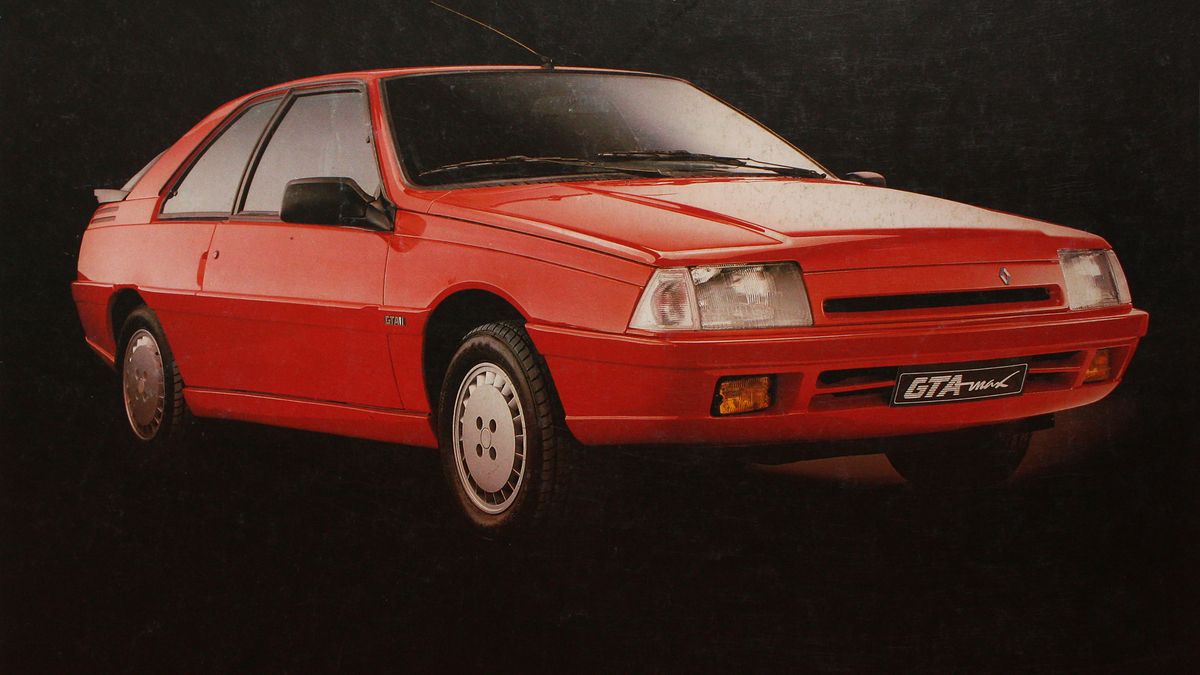With the name Fuego, the French brand interrupted the identification of its models with numbers and aligned itself with the criteria adopted with other of its remembered sports cars such as the Floride and the Alpine.
The new Renault coupe was developed from the Renault 18 platform, but with some modifications that fit its sporting claims. One of the great challenges of the project was to conceive a car with aerodynamic qualities but without sacrificing its habitability. The Renault Fuego was the first mass-produced four-seater sports car designed with the assistance of the wind tunnel. With this technology, a low aerodynamic coefficient (CX) of 0.34 was achieved, achieved based on rounded lines, without protuberances, and a reduced frontal section.
Responsibility for the design was left to Michel Jardin, who worked in a team coordinated by Robert Opron, a renowned designer with a vast professional career in the French automotive industry.
Jardin’s inspired pencil lines conceived of a high-glazed, low-shoulder coupe accented by ribbed plastic trim that ran the full length of the side and wrapped around the tail. A detail that gave the Renault Fuego a strong personality was its fully enveloping bubble-shaped rear window. It was framed with a wide neoprene weatherstrip that at the base became a small deflector. The lunette functioned as a gate with opening from the inside.
Despite being a sports car, the cabin space that could comfortably accommodate its occupants was not neglected. The front-wheel drive and the arrangement of the engine ahead of the front axle, and inclined 15º, determined a low and flat floor and a pointed nose. At the same time, the high roof, which was only broken at the height of the backs of the rear seats, provided comfortable space for the occupants of the rear seats.
The beginnings of the Fuego coupe
During the first year it was offered with two engine options, 1.4 liters (TL/GTL) and 1.6 liters (TS/GTS). From 1981, the TX and GTX versions equipped with the 2.0-liter engine were added. The European line also had a 2.0-liter turbodiesel engine and a 1.6-liter turbocharged gasoline version that produced 132 hp and reached a top speed of close to 200 km/h.
The Renault Fuego was an immediate success. In 1981 it became the best-selling coupe in Europe. With these unbeatable records, he would arrive in Argentina.
In Argentina
While the Renault Fuego started its successful commercial career in Europe, in Argentina the automotive industry was going through a stage of strong transformations. The Automotive Reconversion Law had modified the rules of the game. The opening of imports forced the terminals located in the country to renew their product offerings to respond to the demands of a market that had become more competitive.
Renault Argentina accepted the challenge. In 1979, the subsidiary of the French company announced a millionaire investment plan for the technological update of the Santa Isabel industrial complex, the renewal of the production line and the launch of new models. At the same time, Renault expanded its local supply by importing cars and trucks from its parent company. As part of this commercial strategy, in the second half of 1981 the first units of the Renault Fuego arrived in the country.
National Production
The arrival of the Renault Fuego in the country coincided with the last months of the Torino production cycle, which was saying goodbye after 15 successful years. The national market registered an evident change in trend towards medium-sized models of European origin that were gaining space to the detriment of the classic large North Americans. In this context, the diamond coupe could occupy the space left by the iconic Argentine car in the offer of models with sports performance, a segment where Renault registered the Alpine antecedent, an aggressive version of the R-12.
The rearrangement of the local market and the fact of sharing the Renault 18 platform -which had been manufactured in Santa Isabel since the end of 1980- combined favorably so that the Fuego coupe was added to the production line of the Cordoba factory. Between March and June 1982, the first pre-series units were manufactured and serial production began in July. The Argentine coupé was born with 50% national integration, which just a year later increased to 63%.
Renault Argentina opted for the GTX version, the most powerful in the range. With the closure of imports, after the Falklands War, the coupe market had been reduced to just two options: Renault Fuego and Ford Taunus GT. One month after production began, the sports car with the diamond took 59.9% of its category. During the first year, sustained demand forced its lucky buyers to register on a waiting list to access the coveted coupe.
The Renault Fuego shared the 1,995 cc M 2000 engine with the Renault 18, but with some modifications, such as the double outlet exhaust manifold, which allowed it to increase its power to 103 hp and improve its speed and acceleration values without compromising the fuel consumption. It reached a maximum speed of 185 km/h and accelerated from 0/100 km/h in 11”. Despite its sporting qualities, it offered one of the best drinks in the country. It could travel 15.1 kilometers per liter at a stabilized speed of 90 km/h.
In the passenger compartment, it inherited the instrument panel from the Renault 18, but differed in details such as the steering wheel and the exclusive “petal” type seats, which ensured greater lateral support. Upholstered in leather, they had integrated adjustable headrests and lumbar support. Without losing its sporting qualities, the Renault Fuego did not neglect the luggage space that could be increased by individually folding the rear seat backrests.
The standard equipment included electric window lifters, air conditioning, AM/FM radio with autoreverse cassette player, electromagnetic door lock, digital clock and spot light for the passenger.
The Fuego coupe had everything you could ask for in performance, technology and equipment in an early 1980s sports car. Still, Renault continued to improve it throughout the decade. In 1985 it incorporated hydraulic steering and, as an option, a state-of-the-art three-speed automatic gearbox combined with a new integral electronic ignition system (AEI), the first of its kind installed in a nationally produced car.
At the end of that year the first changes were introduced. The most significant modifications were seen in the interior with a redesign of the instrument panel that adopted a visor-type style. The equipment was updated with a new programmable AM/FM stereo radio with automatic station search and digital readout. On the outside, light alloy wheels and new body colors stood out. A distinctive detail of this new series was the incorporation of the original central locking system with remote infrared control called “Plip”, a name derived from its inventor, Paul Lipschutz.
More power. More Argentinian
In the second half of the decade, the Renault Fuego had been discontinued in Europe, but in Argentina it still enjoyed an appreciated demand that kept it at the top of the coupe market with a 60.4% share. To ensure leadership, from 1987 its performance was increased with the incorporation of the new J6T – 792 2,165 cc engine that delivered 116 hp. With the new power plant it reached a maximum speed of 193 km/h and accelerated from 0/100 km/h in 9 seconds. The equipment was updated with the introduction of an on-board microcomputer with 8 functions and electrically controlled exterior mirrors. The exterior was updated with a new grille and 14-inch alloy wheels with a renewed design. In terms of safety, disc brakes were introduced on all 4 wheels, making the Renault sports car the first national industry car with this equipment.
In November 1988, the Renault Fuego introduced the most important stylistic changes since its launch in the country with the presentation of the GTA model. The restyling gave it a renewed and aggressive aesthetic, inspired by the French Renault Alpine GTA, which updated it without losing its essence. The update was evident in the new bumpers matched with the body color, the grille with a horizontal opening and the side molding that lost its characteristic grooves. New aerodynamic skirting boards, plastic skid plates with integrated “GTA” badging, exterior flag-type mirrors, and new alloy wheels freshened up its profile. Added to these details were rear lights with a translucent dark hue, a new rear deflector and rear ventilation outlets, among other modifications.
In the passenger compartment, the design of the seats was renewed, which could be upholstered in both fabric and leather, and a new audio system with satellite commands behind the steering wheel was incorporated.
With these changes, the Fuego coupe entered the 1990s with a consolidated category leadership, but there was still room to improve the species with a new version: GTA Max. Maintaining the main features of the previous model, it introduced improvements to its engine that increased its power to 123 hp. With this propellant, it reached a top speed close to 200 km/h. The changes in performance were accompanied by innovative details on the outside such as the stop light integrated into the rear deflector, double exhausts and a new graphic that identified the version. In the passenger compartment, the steering wheel was replaced by one with greater grip.
In September 1992, the industrial life of the Renault Fuego came to an end, after producing 19,952 units. Behind were more than 10 years of commercial and sporting success. The diamond sports car left the Santa Isabel production line to become a legend.
The Fuego coupe on the slopes
The Renault Fuego made its debut in the TC2000 during the 1985 season. That year it achieved its first victory with Ernesto Bessone at the Las Flores circuit. This victory confirmed the potential of the diamond car and was only the warning of what would come from the following year.
In 1986 Renault presented an official team prepared by Oreste Berta, made up of drivers Juan María Traverso and Ernesto Soto. During that season, Traverso won four competitions and won the category title. The following year, the remembered Silvio Oltra retained the crown with an unofficial coupé.
Between 1988 and 1993 the dominance of the official Renault Fuego was overwhelming, winning all the championships in the category. Traverso did it five times (1988, 1990, 1991, 1992 and 1993) and the rest was for Miguel Ángel Guerra (1989).
During its time in the TC2000, the Renault Fuego won 66 competitions.
a touch of magic
In 1982, Oreste Berta developed a high-performance kit based on the M 2000 engine. Modifications included a redesigned camshaft, a new obliquely arranged air filter, and a new 4-1 exhaust manifold, manufactured by Cañossilen. These innovations increased power to 134.8 hp and raised torque to 17.69 kgm.
With the Berta kit, the Fuego coupe could exceed 197 km/h and reached 100 km/h from a standstill in 10.48 seconds.
Source: Ambito
David William is a talented author who has made a name for himself in the world of writing. He is a professional author who writes on a wide range of topics, from general interest to opinion news. David is currently working as a writer at 24 hours worlds where he brings his unique perspective and in-depth research to his articles, making them both informative and engaging.




